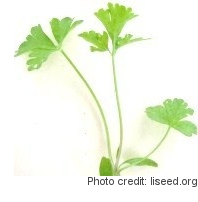Growing Parsley Micro-Greens Indoors – Step-by-Step Instructions

Growing parsley micro greens indoors can be a highly rewarding experience and a fun indoor activity for the whole family. Be aware, however, that parsley seeds are relatively difficult to germinate, so if you are new to indoor gardening, you may want to start with other microgreens such as sunflower shoots or radish microgreens which are easier to grow. Once you are ready to grow your first micro parsley crop indoors, the following step-by-step instructions on how to grow parsley microgreens indoors should help you grow a plentiful crop of tasty microherbs that can be used as a flavorful garnish to many dishes.
Step 1
Purchase high-quality parsley seeds from a reputable supplier. Both curly leaf parsley and flat leaf parsley can be grown indoors as microgreens. Flat leaf parsley is usually easier to cultivate. Whether you opt for curly leaf parsley or the flat-leaf variety, it is a good idea to soak the seeds in lukewarm water overnight before sowing.
Step 2
After soaking the seeds, add ready-made seed-starting soil to a container, filling it to within half an inch from the top. Next, scatter the soaked parsley seeds over the seed-starting soil, being careful to spread them as evenly as possible. Rake lightly with a fork to mix a little soil with the seeds. Cover the soil with a moist paper towel and place the container in a dark place indoors. Be sure to keep the paper towel and the soil moist until the basil seeds germinate. This usually takes 4 to 7 days.
Step 3
Once your parsley seeds have germinated, remove the paper towel and move the container near a bright window or on a sunny kitchen counter to ensure the young parsley seedlings get plenty of sunlight. If you're growing parsley microgreens during the darkest months, you may want to consider buying a grow light which will provide your indoor microgreen garden with extra light.
Step 4
Check the soil daily and water gently but thoroughly with a spray bottle when the soil is dry to the touch. Never allow the seeds or germinating microgreens to sit in water. Overwatering could ruin your entire parsley microgreen crop as these young and delicate seedlings are very vulnerable to overwatering. Curly leaf parsley is particularly vulnerable to over-watering.
Step 5
Harvest parsley microgreens when the first true leaves develop. Note that the first leaves you see when the seeds germinate are cotyledon leaves which don't look anything like parsley leaves. The next set of leaves is the first set of true leaves. It usually takes parsley a couple of weeks to grow the first set of true leaves.
To harvest micro parsley, simply shear the stems off by cutting off everything except the very bottom of the stem. Use harvested micro parsley immediately, if possible. Micro basil, which boasts a flavor that is like a milder version of mature parsley, can be used to garnish salads, soups, meats, vegetable dishes, and sauces.
If you need to store parsley microgreens, place them upright in a tall glass containing about half an inch of water, then cover the glass with a loose-fitting plastic bag and refrigerate. Use within a few days.
Step 6
Once you've eaten your parsley microgreens, start a new crop or try growing other vegetables and herbs as microgreens. Easy-to-grow microgreens include sunflower shoots, snow pea shoots, and radish microgreens.

